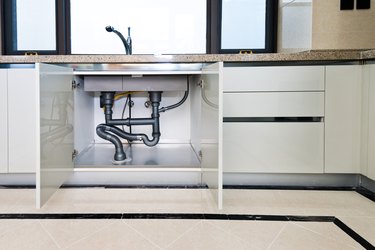
With so many plumbing pipes running through them, it's not surprising that the cabinets under your kitchen sink can sometimes become damp. What does surprise some people is that this can result in mold under the sink. Because dark, damp locations are breeding grounds for mold, mold under the kitchen cabinets can spread quickly. Prompt removal of any mold under a sink will keep it from spreading and protect your family's health.
Find the Water Leak
Video of the Day
Before you get started on removing mold and mildew under a sink, you'll need to first find and fix the leak causing the moisture in the cabinet. Under a kitchen sink the source could be anything from a leak in a water or drain pipe to a leaking garbage disposal or dishwasher. It might even be caused by water seeping under the kitchen sink and dripping into the cabinet below.
Video of the Day
Mold will only grow where there is moisture, which is why it's so important to take care of the source of the moisture. Moisture can also come from items such as wet or damp rags, so it's important to allow them to dry out before storing them in a cabinet. Once you've taken care of the source of the moisture, you can focus on removing mold and mildew under the sink.
How to Remove Mold
Step 1: Don Protective Gear
Put on eye protection and rubber gloves for protection against the cleaning solution and a dust mask to avoid breathing in the cleaning solution and spores from mold under the sink. Open a nearby window for ventilation.
Step 2: Prep the Cleaner and Cabinet
Remove all items from the cabinet and throw away any mold-infested items in a sealable plastic bag. Fill a spray bottle with a mixture of warm water and ammonia-free cleaner, or a commercial cleaner designed to kill mold and mildew. You can also use bleach, though bleach can discolor your cabinets, or a natural product like distilled white vinegar. Never mix these cleaning products together.
Step 3: Apply Cleaner to Mold
Spray the cleaning solution onto the mold. This will kill the mold while dampening and preventing mold spores from becoming airborne. After spraying, let it sit for a few minutes to give the cleaning solution time to kill the mold under the kitchen cabinets.
Step 4: Scrub Moldy Areas
Scrub the area well with a scrub brush. Fill a bucket with warm water and wet a soft rag. Use the rag to wipe the cleaning solution and mold from the areas you have sprayed and scrubbed. Be sure to rinse the rag often or use more than one rag to prevent spreading mold back to the area where you are trying to remove it.
Step 5: Dry Well
Dry the cabinet promptly and thoroughly with soft dry rags or towels. Inspect the area for signs of mold. If you find there is still mold and mildew under the sink, repeat the cleaning steps again. Make sure to dry the area well each time. When it looks like you no longer have mold under the kitchen cabinets, dispose of the cleaning rags in a plastic bag. Leave the cabinet doors open for a few hours to make sure it is completely dry before placing items back under the sink.